– contributed by Rhonda Rinehart.
April is National Poetry Month. In recognition of all of those terrible poems you wrote in high school, and in honor of armchair poets everywhere, CCHP is posting a blog about creativity.
with painted clothes upon a bridge, she was not iodined with garnishes; those
passing there, seared and grotesque. did she jump, or wail, or swing on other
clothes? did she spread her teeth inventing whistles for the quaying bikes, or
stiff snouters turned in grey? she did not, nor did she cow or pace about in
ruins, or tray her hiked up shoes more nearly like galosh or spidern heels she
cut among the grass.
[Excerpt from untitled poem written by ‘Larry’ (Laurence d’A. M. Glass), from the Silvan Tomkins papers, Cummings Center for the History of Psychology]
What makes “good” poetry, and how do you know when you see it? Can poetry be judged on simple merits of being good or bad?
Whether the above poem elicits provocative imagery or just annoys the reader with a bunch of made-up words and awkward sentence structure (the spellcheck was practically shouting at me while typing), we can probably agree that something creative like poetry is indeed quite subjective. And like other creative endeavors, writing poetry is an intensely personal act. But so is reading it. The exact elements of Glass’s poem that make us appreciate it or shrink from it, are creativity in action. No rules. No inhibitions. As Dan Wieden so famously (and creatively) proclaimed for Nike, “Just do it.”
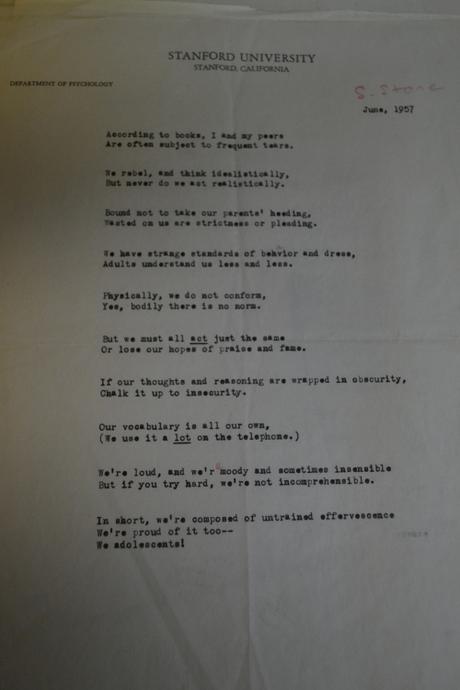
Plenty of CCHP collections possess poetry written by psychologists; still others contain poems from colleagues and family members, like this one from the L. Joseph Stone papers about adolescence, from the Cummings Center for the History of Psychology
If poetry is subjective and arcane, why would we attempt to judge it by a simple scale of good or bad? Or by a right way or wrong way of writing it? Maybe it’s an attempt to make the unscientific more scientific. Perhaps the more pressing question is, should we judge it from those perspectives at all?
Two professors – one of education and one of English – developed “A Measure of Ability to Judge Poetry” in 1921, to assist students in acquiring an “increased ability to tell good [poetry] from bad, and increase preference for the good”. To do this, original poems were sampled, accompanied by sets of varying versions of the original that represented sentimental, prosaic, and metrical forms of writing. From there, it was simply a “which do you prefer?” choice. Similarly, “Literature Tests to Accompany Adventures in Prose and Poetry”, a test developed by Rewey Belle Inglis, asks students to determine prevailing emotions of various poems from a given set of emotions.
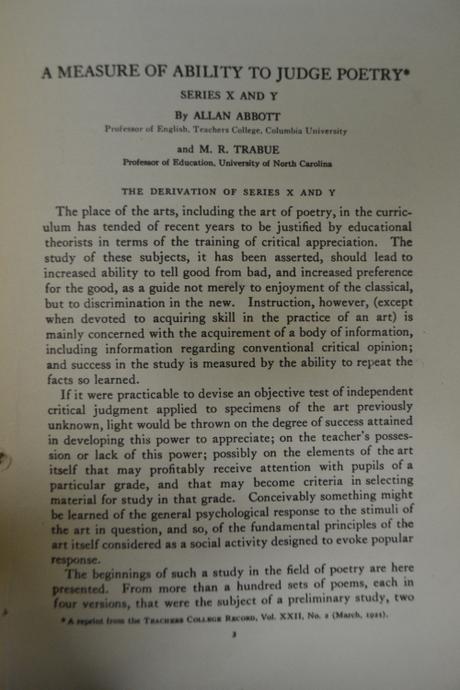
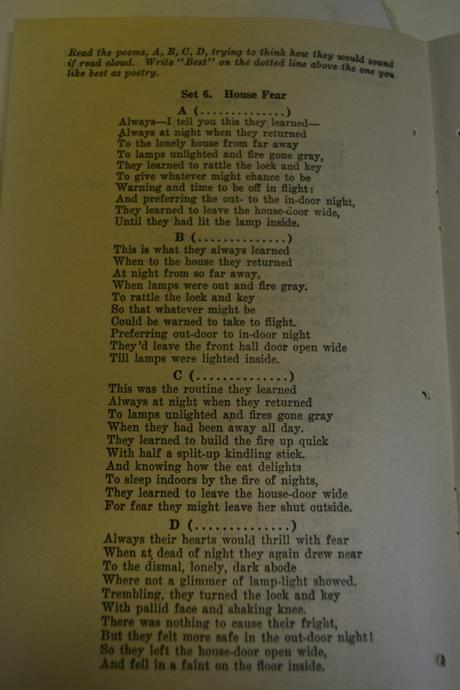
Test preamble and sample poem for “A Measure of Ability to Judge Poetry (Exercises in Judging Poetry)” by Allan Abbott and M. R. Trabue, 1921; from the Cummings Center for the History of Psychology Test Collection
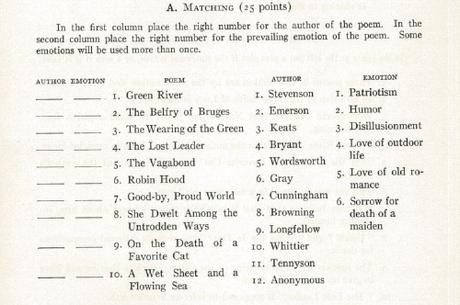
Test page from “Literature Tests to Accompany Adventures in Prose and Poetry” from the Cummings Center for the History of Psychology Test Collection
But making constrained decisions about something that is personal and subjective from pre-selected lists and writing samples feels a little restrictive.
Instead of right and wrong answers, or answers that are compared to regulated determinates, tests like “The Symbolic Equivalents Test”, allow for more fluctuation in the answers. Rather than judging one’s ability to recognize the good and the bad from staid lists, the test-taker is asked to think of his or her own ways to answer each sample. Answers might feel less like straight answers, and more like cleverness and ingenuity. Indeed, creative writing (in the form of poetry or prose) should feel this way.
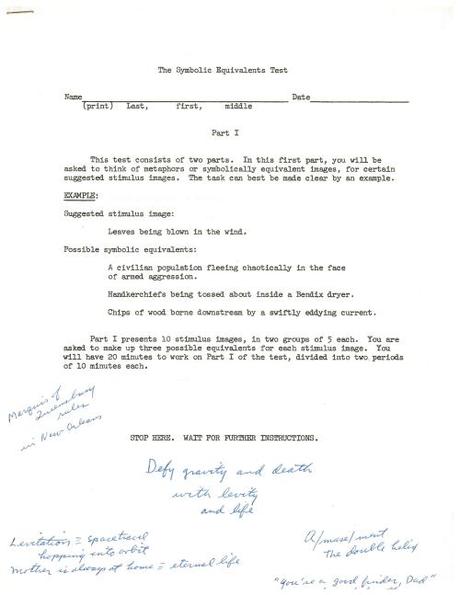
“The Symbolic Equivalents Test” with some imaginative notes, from the Frank X. Barron papers; Cummings Center for the History of Psychology
Throughout the 1960s and ‘70s, Elizabeth Starkweather conducted research on the subject of creativity, particularly in school children. She describes creativity as something that cannot be coerced, and in order to take place, it must happen in an environment of free expression without inhibition.
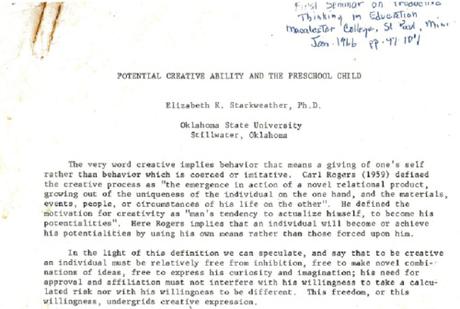
Excerpt from a paper on creativity by Elizabeth Starkweather; from the Cummings Center for the History of Psychology Special Interest Collection
Whether taking a test on one’s own abilities or judging others’ creative abilities, we might be wise to ruminate on the ideas posed by Starkweather, Carl Rogers, Abraham Maslow, and others who recognized that creativity has a lot to with the act and less to do with judging other creators’ works. Think, too, about how the act of creating serves an important purpose in those self-actualization theories. Your poems may get published, you may get recognized for being a great talent; but probably not. Write them anyway. In the mechanized grind of life, creativity helps us to feel human.

poem by Leta Stetter Hollingworth from her published book of poetry titled Prairie Years, from the Leta and Harry Hollingworth papers; Cummings Center for the History of Psychology
" data-orig-size="4608,3072" sizes="(max-width: 500px) 100vw, 500px" data-image-title="photo8" data-orig-file="https://centerhistorypsychology.files.wordpress.com/2017/04/photo8.jpg" data-image-meta="{"aperture":"3.5","credit":"","camera":"NIKON D3100","caption":"","created_timestamp":"1491943457","copyright":"","focal_length":"18","iso":"560","shutter_speed":"0.005","title":"","orientation":"1"}" width="500" data-medium-file="https://centerhistorypsychology.files.wordpress.com/2017/04/photo8.jpg?w=300" data-permalink="https://centerhistorypsychology.wordpress.com/2017/04/24/creativity-in-action-national-poetry-month/photo8/" alt="" height="333" srcset="https://centerhistorypsychology.files.wordpress.com/2017/04/photo8.jpg?w=500&h;=333 500w, https://centerhistorypsychology.files.wordpress.com/2017/04/photo8.jpg?w=1000&h;=666 1000w, https://centerhistorypsychology.files.wordpress.com/2017/04/photo8.jpg?w=150&h;=100 150w, https://centerhistorypsychology.files.wordpress.com/2017/04/photo8.jpg?w=300&h;=200 300w, https://centerhistorypsychology.files.wordpress.com/2017/04/photo8.jpg?w=768&h;=512 768w" class="aligncenter size-large wp-image-2930" data-large-file="https://centerhistorypsychology.files.wordpress.com/2017/04/photo8.jpg?w=500&h;=333" />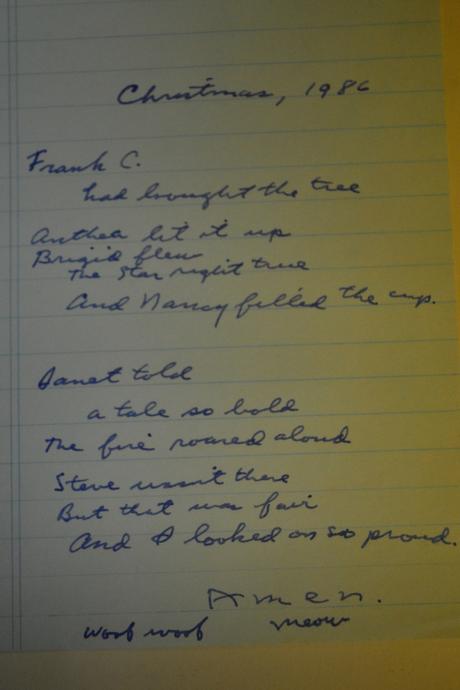
“Christmas, 1986” handwritten poem by Frank Barron, from the Frank X. Barron papers; Cummings Center for the History of Psychology
" data-orig-size="3072,4608" sizes="(max-width: 500px) 100vw, 500px" data-image-title="photo9" data-orig-file="https://centerhistorypsychology.files.wordpress.com/2017/04/photo9.jpg" data-image-meta="{"aperture":"5","credit":"","camera":"NIKON D3100","caption":"","created_timestamp":"1491943695","copyright":"","focal_length":"35","iso":"1000","shutter_speed":"0.005","title":"","orientation":"1"}" width="500" data-medium-file="https://centerhistorypsychology.files.wordpress.com/2017/04/photo9.jpg?w=200" data-permalink="https://centerhistorypsychology.wordpress.com/2017/04/24/creativity-in-action-national-poetry-month/photo9-2/" alt="" height="750" srcset="https://centerhistorypsychology.files.wordpress.com/2017/04/photo9.jpg?w=500&h;=750 500w, https://centerhistorypsychology.files.wordpress.com/2017/04/photo9.jpg?w=1000&h;=1500 1000w, https://centerhistorypsychology.files.wordpress.com/2017/04/photo9.jpg?w=100&h;=150 100w, https://centerhistorypsychology.files.wordpress.com/2017/04/photo9.jpg?w=200&h;=300 200w, https://centerhistorypsychology.files.wordpress.com/2017/04/photo9.jpg?w=768&h;=1152 768w, https://centerhistorypsychology.files.wordpress.com/2017/04/photo9.jpg?w=683&h;=1024 683w" class="aligncenter size-large wp-image-2931" data-large-file="https://centerhistorypsychology.files.wordpress.com/2017/04/photo9.jpg?w=500&h;=750" />